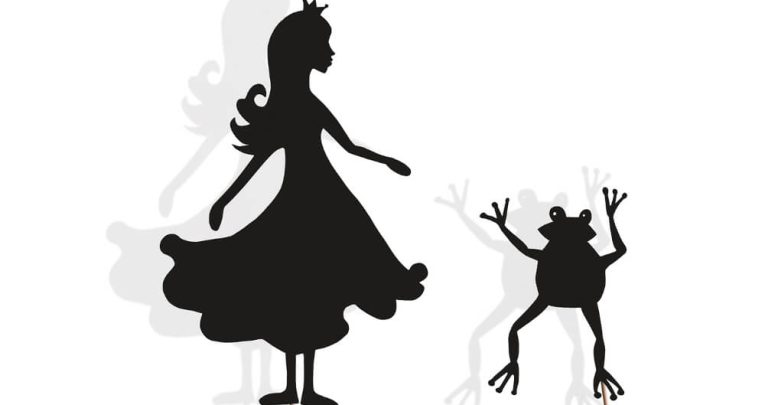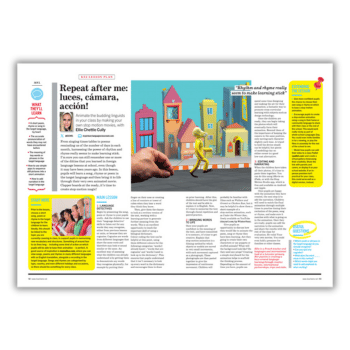Improve Writing in MFL Through the Art of Storytelling

Understanding, enjoyment and appreciation of writing is a requirement of MFL learning – and you can achieve this through the art of storytelling, says Lisa Stevens…

- by Lisa Stevens
- Languages educator, consultant and Global Schools Alliance Ambassador Visit website

The National Curriculum for England Languages Programme of Study for KS2 talks of ensuring that all pupils “discover and develop an appreciation of a range of writing in the language studied” and specifically mentions that they should be taught to “read, understand and select information from a variety of texts” and “appreciate stories, songs, poems and rhymes in the language”.
So we have the enjoyment aspect but also the understanding. Is it possible to enjoy a story without understanding it?
I’d say it is to a certain extent but for enjoyment and appreciation, you need a fair understanding.
So how can we meet both of these criteria for our primary language learners, some of whom will struggle with comprehension in their native language let alone a second – or third!
A safe place
Firstly, why stories?
There is something ‘safe’ about being told a story.
It’s one of the first things we may remember, and forms an important part of childhood.
Sharing a book with a carer, sitting on the carpet at ‘storytime’, reading under the covers by torchlight; all these experiences lead us to feel comfortable and secure when we are presented with a story, whether in written or spoken form.
There are conventions that we learn as we listen to more and more stories that can be applied to each new one that we encounter, and familiar plotlines as good triumphs over evil, the hero reaches the end of his quest and all the mix-ups are resolved.
Therefore, there is already some understanding there even before we start.
Add to that the visual nature of stories that are age appropriate for primary aged pupils where the images form as important a role as the text, and we have a good starting point!
Choosing a familiar story in translation can be helpful.
As the story is familiar, the initial ‘I don’t understand a word’ panic is allayed and from the security of knowing what’s happening, the learner can relax and start to appreciate the sound of the language, begin to recognise repeated words and realise that they do actually ‘understand’.
The added advantage of using stories that children will have encountered previously such as Cher Zoo (Dear Zoo), La Sorpresa de Handa (Handa’s Surprise) and Die kleiner Raupe Nimmersatt (The Hungry Caterpillar) is that there are resources readily available online to support activities round the story that can be adapted into another language.
Equally, all the examples above are very repetitive, which reinforces the key vocabulary, be it words for animals or food or phrases such as “aber satt war sie noch immer nicht” (but he was still hungry) or “Je l’ai renvoyée” (I sent it back).
It’s the way I tell ‘em
The art of telling a story is important too.
I have vivid memories of certain childhood books that are linked to how the story was read to me, and I know from my own children that their favourites were, to some extent, determined by the way they were told, be it the voices used for certain characters, the tone employed or simply the obvious enjoyment of the person sharing the story.
By involving learners in the story and/or storytelling, you not only give them ownership but also invite them along with you on the journey of the tale.
You could use props such as masks, hats, magic wands and so on to signify characters – a shawl for Grandma, a walking stick for Grandpa, a wand for the fairy godmother, a tiara for the princess.
You could use puppets – finger, hand, paper or even marionettes if you have them – to bring children into a tale, or cuddly toys.
Trending
Stories don’t have to be written in prose either. A story can be told in song; for example, La Belle au Bois Dormant (to the tune of There was a princess long ago) is a favourite song-story that allows whole-class engagement as all sing, act la haie d’épines and celebrate the wedding, as well as individual involvement with la belle (tiara), la mechante fée (hat and wand) and le prince (sword and shield).
Likewise, a story can be in play form with longer and shorter parts enabling differentiation.
Doubling up
If you are looking for learners to engage with the written words, you can approach this in a number of ways.
You could use a dual text story where seeing the English sentences alongside the Spanish/French/German is a safety blanket but also serves the purpose of allowing comparison and cross-referencing of vocabulary and structures.
Some present the two languages concurrently, others have a page for each.
Always check that the texts are ‘identical’, however, as some are cleverly translated and therefore comparison is not possible (for example, Aliens love underpants/A los marcianos les encantan los calzoncillos) maintains the rhyming rhythmical quality of the original by altering the text slightly).
Another way of encouraging and supporting involvement is through rebus, texts where a number of words are replaced by an image.
On reading the text, the reader reinstates the appropriate word, provided in the glossary.
For example, in the story Ricitos de Oro, the words casa, cama, bosque, sopa, los tres osos and Ricitos de Oro are replaced by images of a house, a bed, a wood, a bowl of soup, three bears and Goldilocks.
Thus learners can retell a story with you, adding just the missing words, or reading the text as a whole.
Such stories are simplified and condensed to a certain extent and this is something that you can do too. For example, I used the lovely book ¡Fuera de Aquí, Horrible Monstruo Verde! (Go away big green monster!) as my inspiration and wrote my own version using geometrical shapes in PowerPoint in order to introduce more limited, specific vocabulary. Many classrooms (and not just primary ones) use pictograms to support students, particularly as part of a visual timetable, and these images can be used to support storytelling, too.
The wonderful site Pictocuentos.com has a few fairytales told using text and pictograms; Y1 have recently used the story of Ricitos de Oro and a number of children deduced something about word order from watching the words and images in conjunction.
You can make your own stories like these in Spanish using Pictotraductor.com, which ‘translates’ your Spanish text into images.
Just a gesture?
By telling the story using gestures with the children joining in and imitating, they learn the story very quickly.
The use of a story map that supports recall of the story, much like the pictograms or widgets, is also helpful. With the structure of the story memorised, learners then find it simple to innovate, substituting vocabulary to make a new story while staying quite close to the original.
Hence El Nabo Enorme becomes La Zanahoria Enorme, pulled from the ground by a menagerie of animals with the lowly hormiga (ant) making all the difference and causing the carrot to finally leave the earth!
And that’s an example of where understanding and enjoyment meet and move learning forward; learners have a clear grasp of the text and take pleasure of participating in the story, thus enabling them to write an original story in another language that can then be shared with others.
Lisa Stevens is a primary languages educator and teaches at two Birmingham primaries. She has consulted on various projects, including the BBC Schools Radio series ¡Mi Madrid! for KS2 Spanish learners. Find her at lisibo.com and follow her on Twitter at @lisibo.










